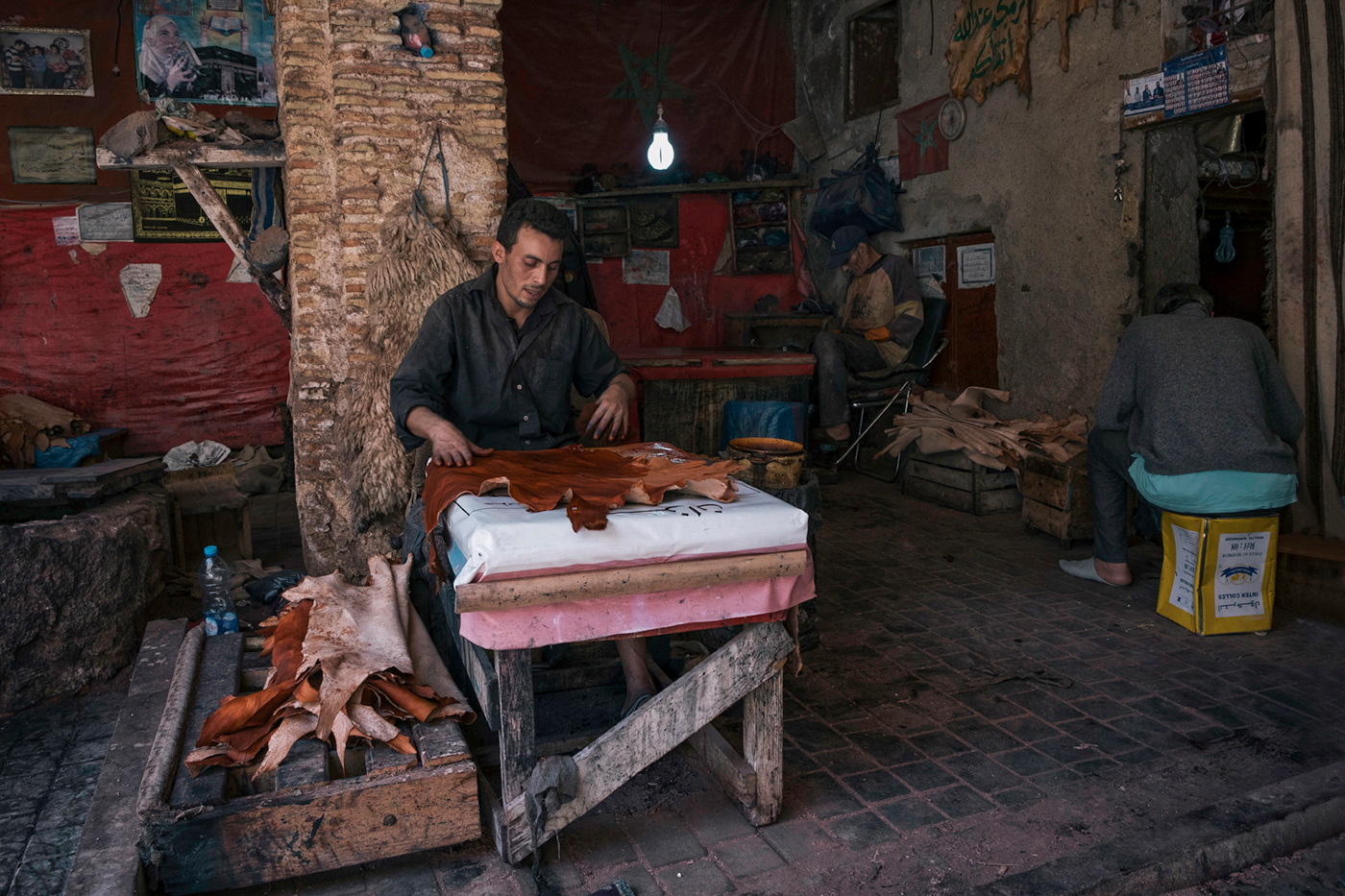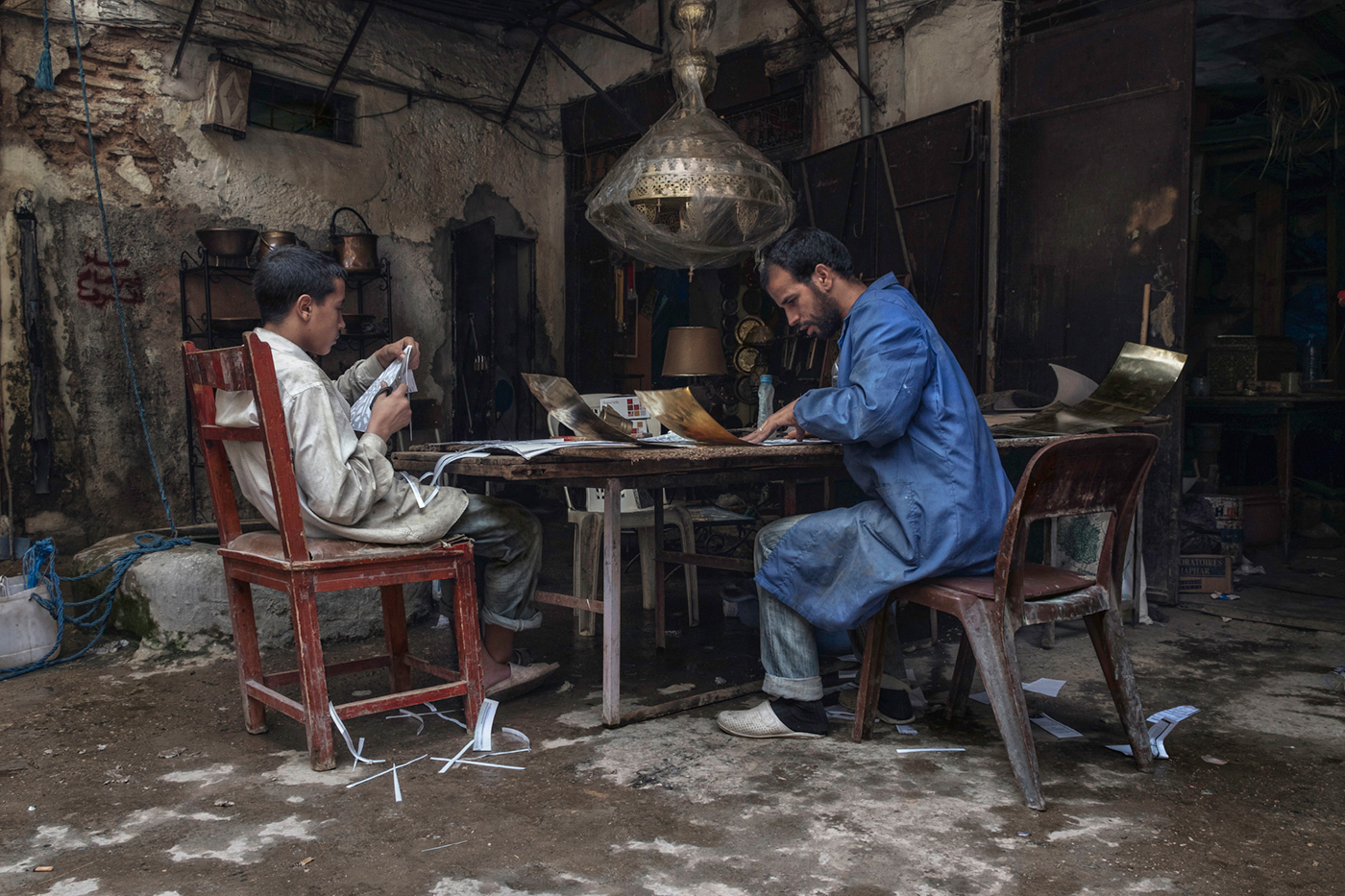
Series of images: The people of Morocco
Morocco is one of those countries that immediately captivated me. Two or three steps into the medina of Marrakech and I was hooked – these colours, smells, the noise of market visitors, the rattling of mopeds… and since we only had a long weekend at that time, a Morocco round trip and especially a detour to the blue city of Chefchaouen is on the bucket list. One person who took two weeks to travel the country this fall is photographer Andy Gawlowski. With his camera, he not only captured great landscapes, but also went in search of special motifs in the medinas. The result is fascinating images that show the people of Morocco at work. And since on the one hand I am enthusiastic about his series of pictures and he asked me so nicely, I am looking forward to today’s premiere. For the first time, there is a travel post with “foreign” pictures. Thank you Andy!
How long were you in Morocco and what was your itinerary?
I was on the road for two weeks and visited the towns of Casablanca (Start), Fez, Chefchaouen, Merzouga, Tanghir, Marrakech and Essouira
What kind of camera and lenses did you take with you on this trip?
The first time I shot on this trip was with the Fujifilm X-Pro 2 and two lenses: 18-55mm f2.8-4 and 14mm f1.4. I actually come from the Canon world and tried the Fuji system as a test. A great camera.
You were sometimes on the road with local guides – was that helpful?
This is indeed very helpful for my kind of photography and also quite inexpensive in Morocco. A personal guide not only speaks the local language, but also shows you places and places that would otherwise be difficult to find. This gives you the opportunity to take very personal pictures, to dive a little deeper into the culture of a country. It makes sense to discuss and prepare the tour with the guide in advance. So my guides were able to adapt very well to my wishes.
Your personal travel highlight?
My personal highlight was the short trip to the Sahara, where I spent one night. I had never been to the desert before, so this was a very special experience for me. It’s probably one of those moments that stays with you forever. Basically, Morocco is full of highlights. It’s the great landscapes, the vibrant medinas, the flattering scents and colors of the country and, of course, the hospitality of the Moroccans that make this destination so special. I will definitely return one day.
And what didn’t work out or disappointed you?
Basically, Morocco inspired me from the first to the last moment and I can’t remember any real negative situation. If I had to choose something, it would be my two-day stay in Marrakech. The city is very much focused on tourism, which can get on your nerves after a while. On the one hand, the streets are crammed with people during the day, on the other hand, the vendors in Marrakech are a bit more intrusive than in other places. But all this is absolutely within limits and is far less bad than I would have thought. A good trick is to just get up very early. Then you have the city to yourself and the sellers are still too tired to be able to fully use their sales strategies. In addition, the light is very special around the early morning hours, which usually has a positive effect on the pictures.
and now to your pictures – tell us how they came about:
The photo was taken on a tour through the medina of Fez (the largest in North Africa). In the southern part of the old town, you hardly meet any tourists, but locals who go about their daily business. There is also a corner that is a kind of “food market” where, among other things, live chickens are sold. I wondered why all the chickens sit so well and don’t move. My guide then told me shockingly that their legs were cut off. Ouch.
This photo was also taken in the medina of Fez. It shows the workers in the city’s largest tannery. The leather is still produced in a very traditional way, without any machines. It smells very strongly of various chemicals and fumes. The work is undenbkar hard and also very unhealthy – because of the chemical baths, in which the tanners sometimes stand for hours without any protective clothing. I was told that as a result, the life expectancy of tanners is less than 50 years.
After tanning, the finished leather is dyed by hand for all kinds of applications (bags, jackets, shoes, etc.). The paint is made from a mixture of natural dyes and chemicals. The craftsman dyes up to 100 such leather hides per day, which he holds in front of him in the photo. His hands look like those of a painter. Countless colors cover his skin. The color is so strong that he can’t wash it off his skin after years of working in the dyeing plant.
This photo was taken in the city of Merzouga, in the immediate vicinity of the Sahara Desert. It shows a tiny little electrical shop. It’s just big enough to fit a chair. I had a chat (my guide translated) with the owner in the picture. He has had this shop for over 30 years and is known in the city for his electrical repairs. He is probably better trained than any of our qualified electrical engineers.
This photo was taken in Chefchaouen, the blue city, which is completely blue and white. The blacksmith proudly told me that he is the third generation to run this mini-blacksmith’s shop, which is also his shop. It is less than 2 m² in size. He simply climbs over the anvil in the morning (there is no door) and is thus in the middle of the restaurant. I bought two small horseshoe keychains from him. Happiness is a welcome companion when traveling. So it was also very fortunate that I found this blacksmith and was able to take this photo.
These two gentlemen make the beautiful golden lamps that hang above the table. The apprentice on the left cuts out the distinctive patterns of the lamps from paper and then glues them to the shimmering sheet metal. The craftsman on the right then punches and cuts these filigree patterns into the sheet metal and then bends it into shape. A job that obviously requires a lot of experience and feeling for the material.
I stood in front of his counter for a while and didn’t understand what he was doing because the table was free. Suddenly, he grabbed one of the chickens hidden under the counter, immediately cut its throat and then dipped it in hot water, only to peel off its skin minutes later. He then cut up the chicken and sold it. It was a horrible scene.
This photo was taken in one of the countless alleys of the medina in Marrakech. Far behind the center of the city, the large square Djemaa el Fna, there are numerous small manufactories that produce a wide variety of products for the tourists. These two gentlemen forge and cut hand knives, as seen on the shelf to the right. This picture also shows how traditional and old-fashioned many manufactories in Marrakech work. Time seems to have simply stood still in Morocco in many places.
This is a traditional bakery in Marrakech, of which there are many. The young man bakes countless of these small (flatbread) breads all day long, which are served as a side dish with every hot dish. The bakery is set into the ground and has no windows. The door is the only source of light. It was incredibly warm in this room. In the middle of summer, at 45°C, it must be unbearable.
Morocco is the land of dates and pistachios. The photo was taken at the market in Essaouira and shows one of the many stalls selling the small delicacies. By the way, it wasn’t that easy to take this photo. Behind me stood another salesman who was tugging at me incessantly. For whatever reason, he wanted to sell me huge quantities of butter. I must have looked like a master baker to him.
All images in this post Copyright by Andy Gawlowski














Leave a Reply